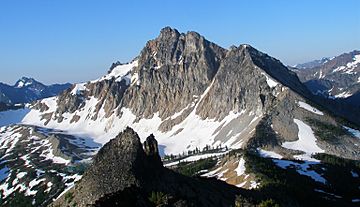Devore Peak facts for kids
Quick facts for kids Devore Peak |
|
|---|---|

Devore Peak seen from White Goat Mountain
|
|
| Highest point | |
| Elevation | 8,360 ft (2,550 m) |
| Prominence | 1,722 ft (525 m) |
| Parent peak | Martin Peak 8511 ft |
| Geography | |
| Parent range | North Cascades Cascade Range |
| Topo map | USGS Mount Lyall |
| Type of rock | Granodiorite |
| Climbing | |
| First ascent | July 28, 1940 by Everett Darr, Ida Darr, Abigail Avery, Stuart B. Avery, Jane Foster McConnell, Grant McConnell, Paul Parker |
| Easiest route | Climbing class 4 |
Devore Peak is a tall mountain in Washington state. It stands about 8,360 feet (2,548 meters) high. This peak is part of the North Cascades mountain range. It is located within the Glacier Peak Wilderness. The mountain is in Chelan County. It is managed by the Wenatchee National Forest.
The closest higher mountain is Martin Peak. It is about 3.36 miles (5.41 km) southwest. Tupshin Peak is about 1.55 miles (2.49 km) north-northeast. Water from Devore Peak flows into nearby Lake Chelan. This happens through small streams that feed the Stehekin River and Devore Creek.
Understanding Devore Peak's Weather
Have you ever wondered why mountains get so much snow? Most weather systems start over the Pacific Ocean. They then travel northeast towards the Cascade Range. When these weather systems reach the North Cascades, the tall peaks force the air upwards. This process is called Orographic lift. As the air rises, it cools down. This causes it to drop its moisture as rain or snow.
Because of this, the North Cascades gets a lot of precipitation. This is especially true during winter, when heavy snowfall occurs. Winters are usually cloudy. However, in summer, high pressure systems over the Pacific Ocean become stronger. This often leads to clear skies with little to no clouds.
Exploring Devore Peak's Geology
The North Cascades are known for their rugged landscape. You can see sharp peaks, tall spires, and deep glacial valleys. These amazing features were created by geological events. These events happened millions of years ago. They caused huge changes in elevation. This also led to the different climates you see across the Cascade Range.
The Cascade Mountains began forming millions of years ago. This was during the late Eocene Epoch. The North American Plate was slowly moving over the Pacific Plate. This caused many volcanic eruptions. Glacier Peak, a large volcano, started forming about 19.74 miles (31.77 km) southwest of Devore Peak. This happened in the mid-Pleistocene period.
Also, small pieces of the Earth's crust, called terranes, helped form the North Cascades. This happened about 50 million years ago.
During the Pleistocene period, which was over two million years ago, glaciers played a big role. They moved forward and backward many times. As they moved, they carved out the landscape. They left behind piles of rock debris. The "U"-shaped river valleys you see today were formed by these glaciers. The combination of land uplift, faulting, and glaciation has created the tall peaks and deep valleys of the North Cascades.



